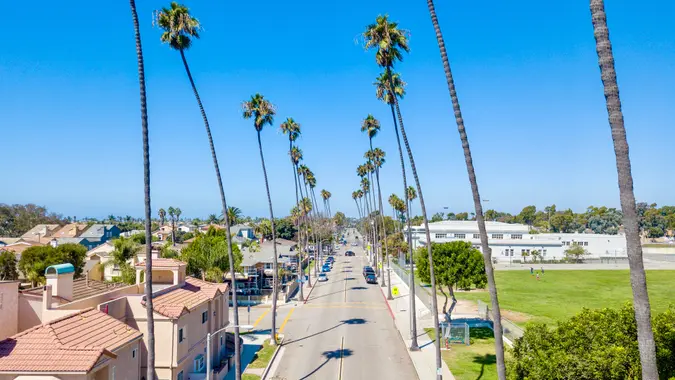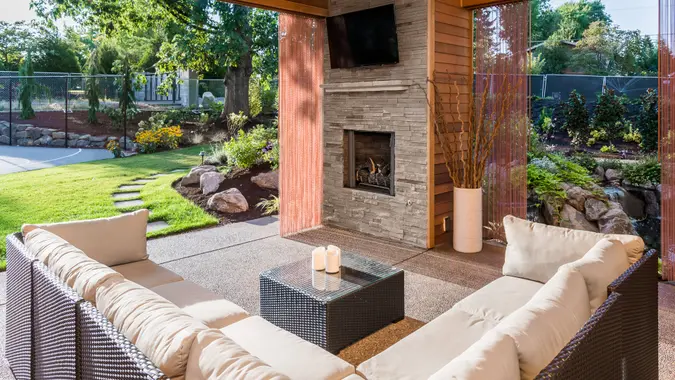7 Ways To Invest In Real Estate in a High Tariff Economy

Commitment to Our Readers
GOBankingRates' editorial team is committed to bringing you unbiased reviews and information. We use data-driven methodologies to evaluate financial products and services - our reviews and ratings are not influenced by advertisers. You can read more about our editorial guidelines and our products and services review methodology.

20 Years
Helping You Live Richer

Reviewed
by Experts

Trusted by
Millions of Readers
While President Donald Trump’s tariffs on products that the U.S. imports from other countries are shifting from week to week, and even day to day, some are likely to persist.
A high tariff economy means higher prices are passed on to consumers and they can impact almost every sector, including real estate. Current or potential investors may feel uncertain what moves to make and whether it’s still a good time to invest.
Experts explained how investors can assess the market under these conditions.
Accept That Lumber Prices Will Increase
One of the most essential elements of any building is lumber, and the U.S. imports much of its lumber from Canada, according to Bo Belmont, CEO and founder of the fractionalized real estate investing company Belwood Investments.
“[N]ew home builders and developers are going to see significant cost hikes as tariffs take effect,” he said.
Invest In Fix-and-Flips and Established Properties
As a result of high lumber prices, people looking to invest in real estate should consider “fix-and-flip properties” as an alternative to new builds, Belmont said.
Or they should look for properties that need “surface-level” updates over full-blown renovations, according to Ryan Dossey, founder of SoldFast. “I always prefer newer [and] cleaner properties to stuff from the 1800s needing six figures worth of restoration,” Dossey said.
Additionally, investors may want to choose properties that were very recently renovated with pre-tariff material and labor costs and properties with long-term, fixed rate debt, according to Derrick Barker, CEO and co-founder of Nectar, a platform for real estate operators to access capital.
“Tariffs will make it more expensive to do renovations and construction. It will make it more expensive to operate properties that have high maintenance costs because their systems are old,” Barker said.
Lock In Lower Interest Rates
One way high tariffs could benefit investors is that “it could pave the way for lower interest rates, which would create new opportunities to buy homes ripe for renovation and offer lower carrying costs for fix-and-flip investors,” Belmont said.
While the cost of renovation and restoration materials will rise, lower interest rates might be able to offset some of these costs.
Look To Real Estate Sectors That Might Benefit Most
Modular construction within residential and commercial real estate may benefit most from this high-tariff environment, as well, Barker pointed out, though a lot of these benefits may really end up being trade offs.
“[The sector] could gain favor due to its potential for lower costs and faster building timelines, mitigating some tariff impacts on traditional materials,” he added.
On the other hand, since tariffs make things more expensive to produce, sectors whose tenants rely on international trade, like retail, office and warehouses, may suffer vacancies.
Invest In Cash Flow Positive Assets
If you want to increase your odds of seeing a good return on investment in properties that might be more expensive under high tariffs, Barker recommended investing in assets that are cash flow positive already, though these may be in shorter supply.
“Or invest in properties that will provide supply to a growing market as long as the basis is low enough where you can generate returns using higher construction and labor costs,” he said.
Work With US-Based Companies
Another strategy, which Dossey’s company is doing, is to shift business to local supply houses to save on costs overall. He’s using American companies where he can.
“Sherwin Williams is headquartered in Ohio, and it’s where we get most of our paint [and] flooring. I would suggest hitting up local supply houses over the big-box stores. Recently, I had a window quote from Home Depot for $55,000 and the same product at a local supply house was $37,000. Lastly, we’ve always loved the Amish for cabinets,” he said.
Consider Tax Strategies
Lastly, you may be able to use tax strategies such as cost segregation studies to maximize depreciation and reduce taxable income for investment properties; opportunity zone investments that come with tax deferrals, and/or secure financing that locks in favorable rates, Barker explained.
If you can invest with a “long-term view,” Barker assured investors that there will be tremendous opportunity in the coming years. That said, he acknowledged that it is “a very risk time.”
More From GOBankingRates
- Nearly 1 in 3 Americans Hit by a Costly Holiday Scam, Norton Survey Shows -- How To Avoid This
- Here's What the Average Social Security Payment Will Be in Winter 2025
- How Middle-Class Earners Are Quietly Becoming Millionaires -- and How You Can, Too
- The Easiest Way to Score $250 for Things You Already Do
 Written by
Written by  Edited by
Edited by 

























